[
{
"name": "500x250 Ad",
"insertPoint": "5",
"component": "15667920",
"parentWrapperClass": "",
"requiredCountToDisplay": "1"
}
]
In its 177-year history, the Broad Street bridge in downtown Rochester has carried canal boats, light-rail trains, cars, and trucks across the Genesee River. Now, city officials plan to remove its top layer, exposing the canal aqueduct and converting it into a pedestrian walkway.
The bridge is a key part of the city's ROC the Riverway project, a multi-phase initiative to enhance areas along the Genesee. And while officials have determined that the top layer of the bridge will be removed, no decision has been about the design. That decision will be informed by the bridge's past and the competing visions of Rochester citizens, said a panel of Rochester historians and city officials at a June 19 event at the Central Library.
"This is one of the longest standing structures in our community," city historian Christine Ridarsky said, "and it has a place, I think, in a lot of our hearts." She and deputy city historian Michelle Finn will advise the committee that oversees the bridge's redesign, providing insight into its history.
At the June 19 event, RIT history professor Michael Brown, City Council member Mitch Gruber, Finn, and Ridarsky explored the historical "layers" of the bridge and how its different phases have allowed it to mean different things to different people.
Finn traced the history of the Broad Street bridge back to 1842, when it was completed as part of a project to expand the Erie canal.
The combination of the canal, powerful waterfalls, and fertile soil allowed Rochesterians to produce lumber, flour, and crops, and then transport them across the US and to Europe at low prices. "It is said Queen Victoria insisted her cakes be made with nothing but the finest Rochester flour," said Finn.
When the aqueduct was drained in the early 1900's, ideas for a subway surfaced. The city decided to build a structure that would support both a subway and, above it, a road.
"Together, these new paths were designed to facilitate cross-town transportation and alleviate congestion and accidents on the city streets," Finn said.
The plans excited people at first, who envisioned the redesigned bridge as the gateway to "a greater Rochester."
But as construction stalled and expenses rose, Rochesterians' sentiments toward it cooled. It took seven years to complete the subway, which opened in 1927. Within just six years, requests to turn it into a highway emerged. In 1956, those ideas became reality.
And yet, said Brown, "even before it stopped running, the subway was already generating nostalgia." He described the throngs of people who swarmed the trolley on its last day, "seeking to etch the city's subway in their memories."
The subway, Brown said, became a symbol of what once was and what might have been. But this sentiment remains true primarily for Rochester's white middle class, Brown said, not for everybody.
For Rochester's homeless, the subway has been a shelter from harsh winters since the 1980's.
For members of Rochester's arts scene, it has become a literal and metaphorical underground, a place to hold punk shows and create graffiti art.
During the discussion following the panelists' presentations, several people in the audience said they want to see Rochester's history put on display more. Council member Gruber agreed. "We don't do enough to capitalize and memorialize our history," he said. "It's absolutely our job to find a way to leverage the his tory that we have."
Some also expressed a hope that some of the original aqueduct can be preserved, given its historical significance.
Erik Frisch, manager of special projects for the city and a lead coordinator on the aqueduct project, said there will be ample opportunities for public engagement and input on the project's design. At present, $4.5 million has been awarded for preliminary design work, which will take an estimated 18 to 24 months, but that process hasn't begun yet.
"We are just still ramping up to that," said Frisch. "I'm here, I'm listening, I look forward to engaging."
Speaking of...
Latest in News
More by Efua Agyare-Kumi
-

U of R becomes battleground in China, Hong Kong conflict
Dec 4, 2019 -

Do you need to get out more?
Aug 28, 2019 -

Rochester Sudanese youth protest against massacre in home country
Jun 14, 2019 - More »









